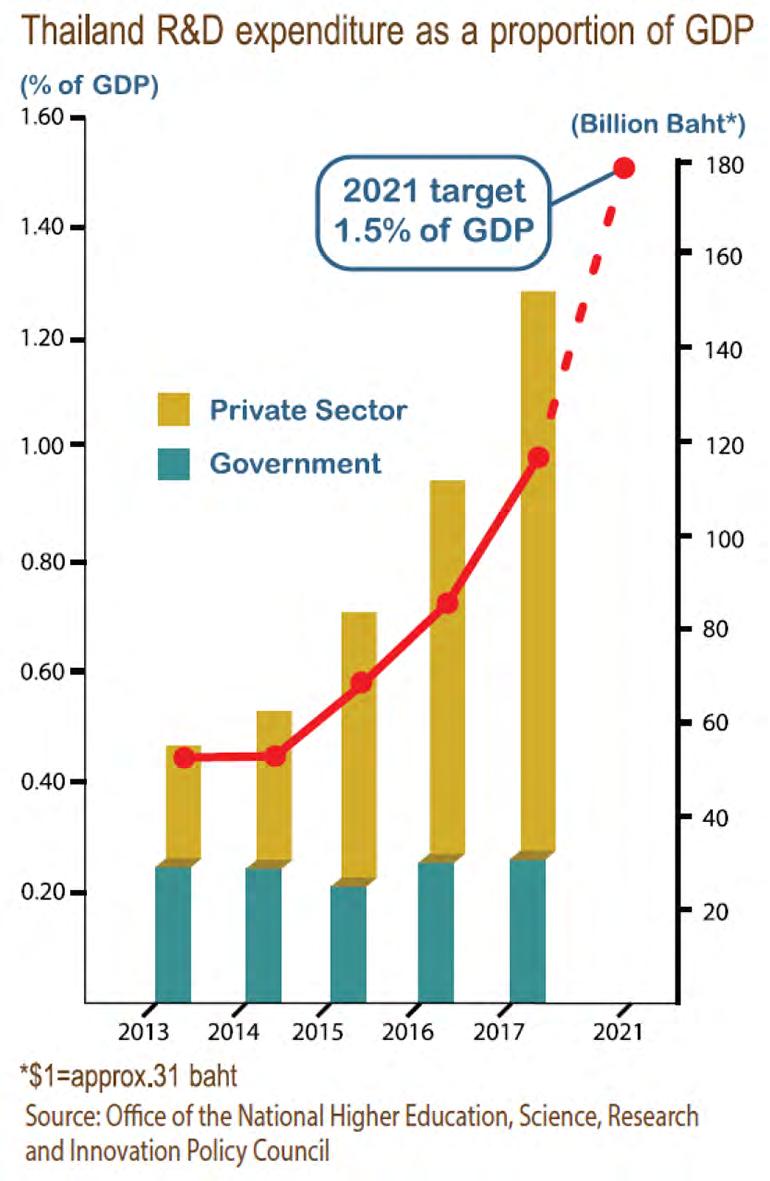
4 minute read
EEC & fast forward to Thailand 4.0 Thailand Board of Investment (BOI)
Of the record 40 million tourists expected to flock to Thailand this year, many will have been lured by images of gilded temples, Bangkok’s magnificent Grand Palace and other testaments to this ancient Kingdom’s rich cultural history.
But for another category of visitor, foreign investors ranging from global giants Hitachi, BMW and Western Digital to fast-growing startups, the focus is firmly on the future as Southeast Asia’s second-largest economy races to transform itself into Thailand 4.0, the region’s innovation and knowledge-based digital hub.
Advertisement
Foreign companies specialising in such advanced technologies as aerospace, artificial intelligence, biosciences, electric vehicles, fintech, robotics and production of sophisticated medical devices are taking advantage of a highly skilled workforce, rapidlyimproving infrastructure and lavish government incentives to move their operations to Thailand.
In an early indicator of this trend, the latest annual ranking of the world’s most competitive economies published in May 2019 by Switzerland-based IMD Business School shows Thailand has leapt five places to number 25 globally, due in large part to a boost in foreign direct investment and productivity.

ASEAN’s 660 million consumers
A key factor in Thailand’s attraction to investors is its extraordinarily strategic location. A country with a
population of 69 million, it stands at the heart of the ASEAN Economic Community, a 10-nation Southeast Asian common market of 660 million consumers.
Now, new high-speed rail lines and roads under construction across Thailand are making the Kingdom the crossroads of a region of 3.4 billion inhabitants — or half the world’s population.
At the heart of this frenetic activity is the Eastern Economic Corridor (EEC), a swathe of territory stretching for 200 kilometers south and east of Thailand’s capital, Bangkok, along a coastal strip that’s already home to long-established automobile and electronics factories.
Here, the government and private investors plan to spend more than $45 billion de veloping environmentally sustainable smart cities, futuristic digital technology parks, fast rail links, three sea ports and other facilities. One of the jewels in the EEC’s crown will be U-Tapao international airport, which will be expanded and linked by high-speed train to Bangkok’s two international airports, reinforcing Thailand’s status as an aviation and aerospace hub. With a 3.5 km runway long enough to take the world’s biggest planes, U-Tapao has already become the base for a nascent aerospace industry.
standards markedly. Gross domestic product per capita has more than tripled since 2000, according to the World Bank. But to avoid the so-called middle-income trap and achieve developed nation status within 20 years, the Thai government in 2015 set about reinventing the economy yet again under the banner of Thailand 4.0.
Its aims are highly ambitious: To help grow industries of the future, the government seeks to sharply increase research and development expenditure. Already, it has achieved notable success, with R&D spending doubling to 1 percent of GDP in the five years to 2017, according to the Office of the National Higher Education, Science, Research and Innovation Policy Council. Now, Thailand is targeting a further increase in the proportion of R&D investment to GDP to 1.5 percent by 2021.
German companies in EEC
Over the past two years, there were 20 German investment projects approved by BOI. The German companies which have been investing in EEC include Leistritz (Blade for Aircraft Engine), RWE Power Climate Protection Southeast Asia Co., Ltd. (Electricity from Solar Panel Installed on the Roof) and HUF (Door Handle Bracket for Automotive) etc.

Tax breaks & smart visas
To attract the most innovative companies, Thailand, through its Board of Investment, is offering an array of incentives, including tax breaks of up to 13 years and renewable smart visas of up to four years for international talent, investors and their families.
Simultaneously, Thailand aims to boost its domestic talent pool by raising education standards across the spectrum, from top research institutions to vocational schools. In total, some 475,000 new jobs are expected to be created in the EEC over the next four years, with just under half of them requiring a bachelor’s degree or higher and the rest needing vocational skills.
Through Thailand 4.0, the country not only hopes to transform itself into a developed nation, but also reduce income disparities by lifting living standards in rural areas. One such initiative: using the digital economy to create 20,000 so-called “smart farmers”.
Similarly, while the EEC will be Thailand’s main growth hub, the government also aims to lure investors to other parts of the country, including the northern capital of Chiang Mai, the resort island of Phuket and the vibrant university city of Khon Kaen in the less expensive, but easily accessible, Northeast. Combined with the new smart cities planned for the EEC, Thailand aims to soon have 10 urban communities that will rank among the world’s most livable cities.

For further details about the Smart Visas privileges, conditionality and application process, please visit www.boi.go.th or register at smart-visa.boi.go.th








